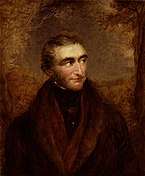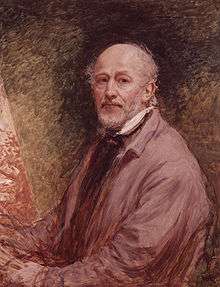Edward Thomas Daniell
Edward Thomas Daniell (6 June 1804 – 24 September 1842) was an English landscape painter and etcher, who is best known for his drawings made on an expedition to the Middle East, including the coast of Lycia, now part of modern Turkey. He was associated with the Norwich School of painters, a group of artists connected by geographical location, as well as by personal and professional relationships.
Edward Thomas Daniell | |
|---|---|
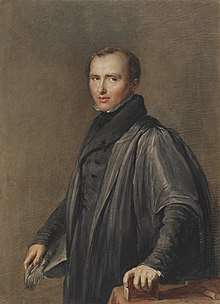 | |
| Born | 6 June 1804 London |
| Died | 24 September 1842 (aged 38) Antalya, Turkey |
| Nationality | English |
| Education | John Crome (Norwich Grammar School); Oxford University |
| Known for | Landscape painting; etching |
| Movement | Norwich School of painters |
Daniell was born in London of wealthy parents: he grew up and was educated in Norwich, where he was taught art by John Crome and Joseph Stannard. He read classics at Balliol College, Oxford, graduating in 1828. In 1832 he was ordained and licensed as the curate at Banham, Norfolk, and in 1834 he was appointed to a curacy at St. Mark's Church, London. In London he became a patron of the arts and an influential friend of the artist John Linnell. In 1840, he resigned his curacy and left England for the Middle East. After touring Egypt, Palestine and Syria, he met the explorer Sir Charles Fellows and joined his archaeological expedition. Whilst on his travels around Lycia, he contracted malaria. He reached Adalia (now known as Antalya), but whilst recuperating there, he died from a second attack of the disease, combined with heatstroke.
As a wealthy amateur artist, Daniell exhibited his paintings but was not forced to earn his living from them. Usually selecting a limited palette, he had a distinctive style that was influenced by Crome, J. M. W. Turner and John Sell Cotman. His etchings demonstrate his great skill in the use of drypoint: his surviving sketches may have been preparatory work for future works. They were printed by Daniell's friend and neighbour Henry Ninham, whose technique he influenced.
Background
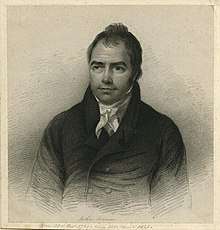
Edward Thomas Daniell was associated with the Norwich School of painters, a group of artists connected by geographical location and their depictions of Norfolk landscapes, as well as by personal and professional relationships. The school's most important artists were John Crome, Joseph Stannard, George Vincent, Robert Ladbrooke, James Stark, John Thirtle and John Sell Cotman, along with Cotman's sons Miles Edmund and John Joseph Cotman. The school was a unique phenomenon in the history of 19th-century British art:[4] Norwich was the first English city outside London where a school of artists arose, and which had the right conditions to create a provincial art movement.[5][6] It had more local-born artists than any subsequently-formed schools elsewhere.[7] The city's theatrical, artistic, philosophical and musical cultures were cross-fertilised in a way that was unique outside London.[5][8] Daniell was, according the author Geoffrey Searle, associated more with the "wider circle of Norwich-based artists" and more weakly linked with his contemporary artists because of his social class, artistic connections in London, and travels abroad.[9]
The Norwich Society of Artists, which was founded in 1803,[10] arose from the need for a group of Norwich artists to teach each other and their pupils. Not all of the members of the Norwich School were members of the Norwich Society,[11] which held regular exhibitions and had an organised structure, showing works annually until 1825 and again from 1828 until it was dissolved in 1833.[12]
At the end of the seventeenth century, other schools of painting had begun to form that associated with artists such as Francis Towne at Exeter and John Malchair at Oxford, and other centres of population outside London were creating art societies, whose artists and drawing masters influenced their pupils.[13] Unlike the artists of the Norwich School, many other provincial artists did not benefit from wealthy merchants and landed gentry demonstrating their patriotism at a time of international unrest, by acquiring picturesque paintings of the English countryside.[14] The Norwich Society of Artists (1803–1833), the first group of its kind to be created since the formation of the Royal Academy in 1768, was remarkable in acting in its artists' interests for thirty years, longer than for any other similar group.[15]
Life
Family
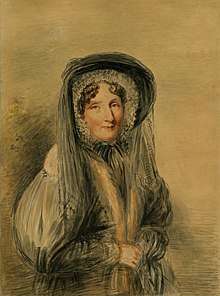
Edward Thomas Daniell was born on 6 June 1804 at Charlotte Street, Fitzroy Square, London, the son of Sir Thomas Daniell, the retired attorney-general of Dominica,[note 3] and his second wife Anne Drosier, the daughter of John Drosier, of Rudham Grange, Norfolk.[18] Daniell's first wife, by whom he had a son and a daughter, had died in London in 1792.[19]
A man of considerable wealth, Sir Thomas Daniell was able to purchase land and slaves in the Leeward Islands, which then formed part of the British Empire. His estates, which included 291 acres (118 ha) at Dickenson Bay, on the island of Antigua, had been bought from the family of his first wife in 1779.[19] He retired and moved to the west of Norfolk,[20] but his health deteriorated, and he died of cancer in 1806, leaving a young widow and an infant son.[21][note 4] In his will he left his Dominican lands to Anne, and his estate on Antigua to his adult son Earle, subject to him providing a guaranteed annual income of £300 to the family in Norfolk. Sir Thomas' slaves were also included as part of the bequest to Anne and her son.[25]
Anne Daniell and her young son moved to 68, St. Giles' Street, Norwich.[18] When she died there in 1836 at the age of 64, she was buried in the nave of St Mary Coslany, Norwich.[26]
Early life and education
Little has been recorded of Daniell's early life, and no anecdotes of his childhood days have survived. He grew up in Norwich and was educated at the Norwich Grammar School, where his drawing master was John Crome. He was taught etching by Joseph Stannard, and during the vacations practised at Stannard's studio in St. Giles' Terrace, which was round the corner from his own house.[18][27] Their influence is apparent in Daniell's early etchings,[28] but he later became more affected by the works of J.M.W. Turner, whom he greatly admired. He became involved in the art world at a young age: the brothers Thomas and Chambers Hall wrote to the artist John Linnell in 1822 about "our young friend Mr Daniells [sic] who accompanied us to your house last week and who wishes to possess a drawing by Girtin".[29]
On 9 December 1823, the nineteen-year-old Daniell went up to Balliol College, Oxford, to read classics.[18] He graduated from Oxford in November 1828,[30] despite having neglected his studies in favour of art.[31] In a letter by Daniell to his friend Linnell, dated the month before his graduation, he wrote: "I find that the examinations for which I am preparing next month require a closer application to my literary studies than I had imagined & that I must not attempt to 'serve two masters' ".[29] He began a Master of Arts degree six months later, on 25 May 1831.[31]
Travels around Europe, Scotland and Ireland
Daniell had the financial means to travel abroad to seek subjects to paint,[32] and of the Norwich School painters, only John Sell Cotman travelled further.[33] During 1829 and 1830 he spent the intervening months between his classics studies and his master's degree on a Grand Tour through France, Italy and Switzerland, producing small oil paintings and watercolours of the local scenery. These watercolours were described by the art historian William Dickes as "well-centred, painted with fluidity and revealing a delicate appreciation of tone".[34]
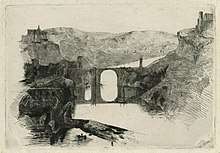
The route taken during his eighteen months on the Continent is revealed by the order of his drawings.[29] In touring Europe, he was acting in a similar way to other wealthy young Englishmen of his day: his travels through Switzerland are reminiscent of those of the artist Captain James Pattison Cockburn, whose works included his Swiss Scenery, published in 1820.[35] When Daniell visited Rome and Naples in 1830, he met the artist Thomas Uwins, who wrote, "What a shoal of amateur artists we have got here! ... there is a Daniel (sic), too, come to judgement! a second Daniel! — verily, I have got more substantial criticism from this young man than from any one since Havell was my messmate".[36] Daniell may also have visited Spain, as his drawings of the country were copied by the Norwich artist Henry Ninham, but there is no direct evidence that he went there himself. It is possible that he returned to Norwich from Europe in time to attend Joseph Stannard's funeral, after his former teacher died from tuberculosis in December 1830, aged 33.[29]
In the summer of 1832 Daniell travelled to Ireland. With his contemporaries from Oxford, George Denison and the author and politician Edmund Walker Head,[37] he went on a walking trip in Scotland, obtaining valuable subject material.[38] His Scottish tour influenced his use of drypoint etching, as he was able to study the work of important etchers such as Andrew Geddes.[39] According to the author Jane Thistlethwaite, Daniell's drawings and etchings of Scottish scenes "testify in their subjects to his enthusiasm for the beauties of Scotland and in their technique to his almost certain acquaintance with the Scottish etchers".[37]
Career in the Church
.jpg)
On 7 October 1832 Daniell was ordained as a deacon at Norwich Cathedral by the elderly Bishop of Norwich, Henry Bathurst, and three days later he was licensed by the bishop as the curate of Banham parish church, a post he held for eighteen months.[40] From letters to John Linnell it is evident that he was rather short of money, and this might account for why he decided to enter the Church.[37] Little is known of his career as a Norfolk curate, but the parish registers for Banham, all of which have been preserved, show that he led an active life within the parish. In Thistlethwaite's view, his "loveliest and most sophisticated plates" were produced whilst he was living at Banham.[37]
On 2 June 1833, he was ordained to the priesthood at Norwich Cathedral, but he continued as the curate at Banham until 1834. That year he was appointed to the curacy of St. Mark's, North Audley Street in London, taking rooms at 77, Park Street, close to Grosvenor Square.[41][42] At this time he also worked at St. George's Hospital, but as with his curacy at St. Mark's, there are no surviving records detailing the work he did.[37]
A letter written in 1835 from Daniell to his old Oxford tutor Reverend Joseph Blanco White gives an indication of the friendship he still felt towards "his old coadjutor". The letter referred to his Norfolk and London parishioners in a jocular way, as when he wrote, "You, probably, thought I was haranguing the plough-boys in Norfolk, and you find me among the Dons of Grosvenor Square, and having to preach (as I must) next Wednesday at St. George's, Hanover Square. I wish you would come and give me some assistance."[43] In about 1836 he moved to rooms at 13 Green Street, near Grosvenor Square and close to St. Mark's, where he stayed until he left England in 1840.[44]
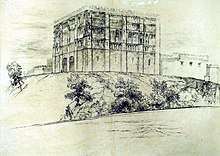
The outer shell of Norwich Castle 's keep was refaced in Bath stone from 1834–9, faithfully replicating the original blank arcading.[45] Daniell was one of the foremost opponents of the proposed refacing. In one of many letters he wrote about the subject, one that appeared in the Norwich Mercury in August 1830 referred to the "scandalous re-facing of the ancient keep".[46] Although living in London when the refacing of the castle keep was being undertaken, his letters to Ninham and his friend the botanist Dawson Turner show that he had not forgotten this contentious issue. In a letter to Turner, Daniell wrote, "I have had a very beautiful drawing made of it, and I mean to etch it the size of the drawing. I can only say that if my etching be half as much like the castle, or half as good as the drawing, it will be more like, than anything yet done, of that very beautiful relic."[47] To Ninham he wrote, "Show me by a plan, how high they have got pulling down, and enable me to judge whether even now in the eleventh hour, any good can be done; and I in return will just inform you, how I stand with regard to my plate. It stands precisely as it did when I left Norwich."[48] His etching of the old keep, however, was never completed.[47]
Tour of the Holy Land
Daniell held a series of dinners from August to December 1839.[49] At a date some time after June 1840,[38] and perhaps inspired by the example of the Scottish painter David Roberts, who had made a long trip to Egypt and the Holy Land to gather subject material,[note 5] he resigned his curacy,[49] left England to tour the Near East, and arrived in Corfu in September 1840.[27] Roberts' drawings of the Middle East are thought to have compelled him to tour abroad, but he had also heard of recent discoveries in Lycia from his friend, the British explorer Charles Fellows.[51] He was in Athens by the end of the year, and had crossed to Alexandria early in 1841, travelling up the Nile to Nubia, and then from Egypt to Palestine, on a route that took him past Mount Sinai.[49] After travelling on to Syria, he reached Beirut in October 1841.[52]
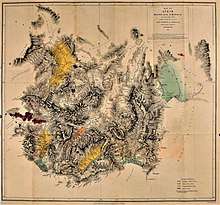
At the Turkish city of Smyrna he met Fellows and joined his expedition, boarding HMS Beacon, a ship sent by the British Government to Lycia to convey home antiquities recently discovered at Xanthos.[54] During the expedition eighteen ancient cities were located.[55] Daniell spent the winter at Xanthos and when Fellows left, he remained to make a more thorough survey of the country, in company with Thomas Abel Brimage Spratt, a lieutenant in the Navy, and the naturalist Professor Edward Forbes.[52] Spratt was responsible for researching the area's topography and Forbes its natural history: Daniell was to make records of any antiquarian discoveries.[49] He recorded their journey by producing a series of sixty-four drawings, now preserved in the British Museum. Laurence Binyon said of them "What strikes one most at first is the astonishing air of space and magnitude conveyed, the fluid wash of sunlight in these towering gorges and open valleys".[56]
After Fellows departed with HMS Beacon on 3 March 1842 to bring back ships more suitable for the task of transporting large marble tombs to London,[49] Daniell travelled to Selge, sketching and exploring the ruins.[57] He copied inscriptions from monuments in Lycia, the Cibyratis, Pisidia and Pamphylia,[58] and also collected coins.[59] He alone visited Selge, Sillyon, Marmara, Perga and Lyrbe.[60] 200 inscriptions were copied by the expedition, in the main by Daniell.[59] The original inscriptions he produced are now lost, but they were published in Travels in Lycia, Milyas, and the Cibyratis, in company with the Late E.T. Daniell, and were transcribed (inaccurately) by Samuel Birch for a book. Now in the British Museum, the book contains a single page of Daniell's original manuscript.[58]
In April 1842 Spratt, Forbes and Daniell arrived overland at Antalya. Spratt and Forbes left the city on before Daniell, who left overland after his meeting with the Pasha.[61] Daniell visited Cyprus that year and painted his only extant watercolour of the island, an untitled work now held in the British Museum and described as Larnaka, Cyprus, from the Sea. He may have produced the work aboard his ship while anchored off shore. Dr. Rita Severis had compared the work with the watercolour paintings of Turner, a painter he was known to admire. In her thesis on artistic representations of the island from 1700 to 1955, Severis stated that "the interplay of the blue of the sea with the sand-colour of the land, the latter colour being repeated in a most successful way in the foreground of the picture, accentuates the distance on one hand but simultaneously enhances the desire for a closer and more attentive look at the subject".[62]
Death from malaria
.jpg)
By late May 1842, the ships HMS Monarch and Media had arrived as replacements for HMS Beacon, and Daniell had accepted an offer of a passage to England.[49] In June, Daniell left Rhodes to return to Lycia and rejoin Forbes and Spratt.[59] He missed his ship—the ships having set sail the previous day— and was forced to amend his plans.[63] There was a chance for him to go back to Rhodes by caïque and join the returning ships there,[63] but he instead travelled to Adalia (now known as Antalya) in the company of the newly-appointed consul for the city, John Purdie. During the journey he contracted malaria.[64] It is likely he became infected as he passed the marshy lowlands of the Aksu Çayı and Kopru Çayi, circumventing a great marsh as he travelled inland.[60]
At Adalia, Purdie helped him to convalesce. During this time Daniell wrote letters to his friends, in which he described his discoveries of sites such as those at Olbia, Appolonia and Lyrbe. He chose to leave Adalia before he had fully recovered, and undertook a solitary expedition to Pamphylia and Pisidia during the hottest part of the year. He was forced back after suffering a second attack of the disease. At the consul's house in Adalia he dictated what was to be his last letter, in which he expressed his intentions to continue his work.[note 7]
.jpg)
He lost consciousness, after sleeping on the front terrace of Purdie's residence, and he died a week later from the combined effects of malaria and heat stroke. He was buried in the city.[64][66][note 8] Beecheno recalled that he was "buried beneath an ancient granite column in the court of a Greek church in the centre of the town of Adalia".[54]
Forbes paid tribute to his friend, saying that his illness "destroyed a traveller whose talents, scholarship, and research would have made Lycia a bright spot on the map of Asia Minor, and whose manliness of character and kindness of heart endeared him to all who had the happiness of knowing him".[57] Roberts wrote, "Poor Daniell, like Wilkie, went to Syria after me, but neither returned. Had Daniell returned to England, I have reason to know, from Turner's own mouth, he would have been entrusted with his law affairs".[37][note 9]
A memorial to Daniell can be seen in the church of St. Mary Coslany, Norwich. His will is preserved in the National Archives at Kew.[69]
Friends and associates
Many of Daniell's etchings were printed by his Norwich friend Henry Ninham, whose home and printing workshop was a short distance from Daniell's house on St. Giles Street,[38] and with whom Daniell corresponded regularly.[70] His friendships with Ninham and Joseph Stannard may have begun when they were at school.[29]
Daniell was one of the best known patrons of the arts of his time, and held regular dinner parties and other gatherings at his London home.[40] His rooms at 77, Park Lane,[47] in Mayfair became a resort of painters that included John Linnell, David Roberts, William Mulready, William Dyce, Thomas Creswick, Edwin Landseer, William Collins, Abraham Cooper, John Callcott Horsley, Charles Lock Eastlake, J. M. W. Turner and William Clarkson Stanfield. Alfred Story, Linnell's biographer, stated that Daniell's home was "a treasure-house of art, and comprised works by some of the best painters of the day".[41][37]
One of Daniell's friends was the writer Elizabeth Rigby, who was also one of his pupils. A private letter from Elizabeth to Frederick Beecheno, written in 1891, explained how her friend taught her etching and showed her drawings to him, and in it is revealed the warmth of the friendship she and her future husband Charles Lock Eastlake felt for him before their marriage. Recalling him in the letter many years later, she wrote of Daniell that "his face was that of one of the openest that could be seen – a superb forehead, and splendid teeth, which showed themselves with every smile, and no one smiled and laughed more genially".[71] In a letter written by Daniell to Elizabeth Rigby, he referred to himself as an example of a "tree and house sketcher".[40][72]
John Linnell
Daniell was an influential friend of the artist John Linnell, whom he first met at Oxford. Daniell acted as his patron, as when in 1825 he promoted for him the sale of Illustrations of the Book of Job by the English artist and poet William Blake. He commissioned him to produce the painting now known as View of Lymington, the Isle of Wight beyond for the price of 30 guineas. At a later date he exchanged it for Boy Minding Sheep, paying the difference of 20 guineas. In 1828, Linnell made a miniature of Daniell, and taught him how to paint in oils.[40][27]
The two friends corresponded to each other regularly and Linnell was a frequent guest at Daniell's rooms in London.[73] Daniell encouraged Linnell to complete his St. John the Baptist Preaching in the Wilderness (1828–33), offering to buy it himself if it did not sell. When the painting was exhibited in 1839 at the British Institution, it helped to enhance Linnell's reputation as an artist.[74]
Linnell first met J. M. W. Turner at Daniell's house in 1838, and used the opportunity to study him prior to painting his portrait from memory, as Turner had previously refused to sit for the artist, and it was notoriously difficult to get his agreement to be portrayed.[75] Due to Daniell's premature death, the painting was never delivered.[76] When Linnell's painting Noon was rejected by the Royal Academy in 1840, Daniell came to his friend's assistance.[note 10] Linnell agreed that the picture be hung in Daniell's house above the fireplace. When his friends, who included Turner and Eastlake, admired the picture, Daniell criticised them and forced them to justify their action, and was quoted to say, "You are a pretty set of men to pretend to stand up for high art and to proclaim the Academy the fosterer of artistic talent, and yet allow such a picture to be rejected!"[77]
J. M. W. Turner
Daniell's friendship with Turner, whom he met when he moved from Norwich, was short but intense. Of all the group of artists that Daniell was surrounded by during his years in London, Turner was considered by them the ablest. He was a regular guest at Daniell's gatherings and dinner parties, and they quickly became close friends.[36] Beecheno, in his E.T. Daniell: a memoir, recalled that on one occasion Turner was asked his opinion of Daniell's work: ""Very clever, Sir, very clever" was the great master's dictum, delivered in his usual blunt way".[1] Elizabeth Rigby wrote of Turner and the artist William Boxall, "His admiration for Turner inspired Turner with genuine affection for him. Boxall has told me that at an R.A. dinner, he and Turner sitting with one between them, Turner leant back, and touched Boxall to attract silently his attention, and then pointing to a glass of wine in his other hand, whispered solemnly, "Edward Daniell"".[71] The painter David Roberts wrote of Daniell, "He adored Turner, when I and others doubted, and taught me to see & to distinguish his beauties over that of others ... the old man really had a fond & personal regard for this young clergyman, which I doubt he ever evinced for the other".[36]
Daniell's watercolours of landscapes seen during his tour of Switzerland (and during his travels in the Middle East) approach Turner's romantic works in their style. Coincidentally, Turner toured Switzerland in 1829, visiting some of the sites that Daniell had previously depicted.[35]
Daniell may have helped to turn Turner towards religion as he approached old age. In his biography of Turner, the author James Hamilton states his opinion that "he would have been able to supply spiritual comfort that Turner required to help him fill the holes left by the deaths of his father and friends and to ease the fears of a naturally reflective man approaching old age".[36] The old artist is known to have mourned his friend's early death deeply, saying repeatedly to David Roberts that he would never form such a friendship again.[76]
Artistic career
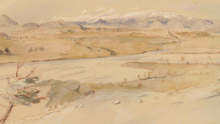
Throughout his life Daniell remained an amateur artist, as befitted his social class. His private income and career as a parish priest freed him from having to earn a living from his etchings and paintings.[39]
The writer Derek Clifford believed that Daniell's free, bold and distinctive artistic style was rooted in the methods of John Sell Cotman, an artist he deeply admired.[78] The historian Josephine Walpole, who believes Daniell's talent has yet to be properly recognised, noted his ability to "create a sense of space, a feeling of heat or cold, of poverty or plenty, with apparent lack of effort".[79] She has written admiring his rare talent and highly individual approach. For her, his drawings are appealing for their "delicacy of outline" and his watercolours, the best of which were produced on his last tour, are "impressive in their simplicity, having a powerful feeling for the landscape involved" and having washes that are "muted but distinctive".[80]
In 1832 he exhibited a number of his own pictures of scenes in Italy, Switzerland and France with the Norwich Society of Artists, which were favourably commented upon by the Norwich Mercury. During the sole instance of an exhibition of Daniell's works with the Society, which was disbanded the following year,[38] he showed four works: Sketch from Nature; Lake of Geneva, from Lausanne, painted on the spot; Ruins of a Claudian Aqueduct, in the Campagna di Roma; and Ruined Tombs, on the Via Nomentana, Rome, painted on the spot.[81]

Daniell's oil paintings, which generally depicted subjects encountered on his continental travels, were shown in annual exhibitions during the time he lived in London.[38] He was an honorary exhibitor with the Royal Academy, showing four works there: Sion in the Valais (1837); View of St. Malo (1838); Sketch from a picture of the Mountains of Savoy from Geneva (1839); and Kenilworth (1840)), as well as four works at the British Institute (The Temple of Minerva (1836); Ruins of the Campagna of Rome (1838); Meadow scene (1839); and The Lake of Geneva, from near Lausanne (1840)).[82][83][16] For his watercolour paintings, he deliberately selected a limited palette, for instance when he made painted freely on buff paper during his tours of the Middle East. The 120 sketches at Norwich Castle and the 64 works in the possession of the British Museum may have been preparatory work for etchings and paintings that were never made.[84]
Daniell served on bodies involved with the arts.[80] He was elected as a Fellow of the Geological Society of London in 1835.[85] and was elected as a committee member of the Society for the Encouragement of British Art in May 1837.[51]
Etchings

Daniell's etchings, though small in number and not exhibited during his lifetime, are the basis for his reputation as an artist.[27][86] The author Geoffrey Searle asserts that only a lack of plates has prevented him from being one of the great etchers of the world.[9] In 1899, Laurence Binyon considered Daniell's etchings to be—from a historical point of view—the most remarkable of his works, anticipating, with their freedom of line, the etching revival personified later in the century by Seymour Haden and Whistler.[64]
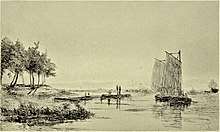
Malcolm Salaman, writing in the 1910s, observed, "No etcher of this early English period evinced a truer and more subtle understanding and handling of the medium than Crome's pupil, the Rev. E. T. Daniell, a very interesting artist of the Norwich School, whose plates, etched in the eighteen-twenties, are remarkable for genuine etcher's vision, expressive charm, and delicacy of craft. His View of Whitlingham, full of light and air, proves him to be in the direct line of the masters".[87]
Dr Miklos Rajnai, formerly Keeper of Art at Norwich Castle Museum, compared Daniell's skill as an etcher with John Crome and John Sell Cotman.[39] The British art historian Arthur Hind has said that his etchings "anticipated far more than nearly anything of Crome or Cotman the modern revival of etching".[88]
Daniell's first etchings were made with Joseph Stannard in 1824 and he became skilled in this particular method of printmaking because of his Norwich connections.[89] An etching made in 1824 of a church tower and trees resembles one by Stannard, who is thought to have taught his friend how to etch.[90] Three distinct groups of etchings can be identified: those produced in Norfolk, including Flordon Bridge, his masterpiece from his early years, which according to Searle has "an assured and individuality"; a more grandiose group of etchings made during Daniell's tours of Scotland and the continent; and those etchings made in Norfolk during his curacy at Banham, which includes his most assured work of this period, Whitlingham Lane near Trowse.[91] Although his Norfolk prints were nearly all of landscapes, they were intended to be artistic rather than topographically accurate, and any figures (that were often pairs of companions) were used simply to indicate the scale of the landscape they were set in.[51]
Whilst still at university, Daniell learnt much from his fellow Norwich artist Joseph Stannard,[38] but later employed a looser style, moving away from the example of his friend and teacher, towards that of Andrew Geddes and other Scottish etchers, whose work he had probably seen while in Scotland in the summer of 1831. His later works excel in the use of drypoint.[38] In Thistlethwaite's view, his large drypoint etchings and Norfolk landscapes became "supremely independent and for his time unique" after 1831, once he had moved away from the traditional style of etchers like Geddes.[51] Daniell is thought to have introduced drypoint etching to his Norwich peers: both Thomas Lound and Henry Ninham etched in this way after 1831, producing works of a quality that approached Daniell's own.[92]
Legacy
Most of Daniell's works are held at either the British Museum, or as part of the Norfolk Museums Collections. The British Museum obtained some of his etchings before 1852 and had purchased his prints as early as 1856.[86] An article by the poet and art scholar Lawrence Binyon on Daniell appeared in 1889.[86]
Daniell stopped etching when he moved to London. None of his etchings were exhibited or published during his lifetime, but some were given to friends. The original impressions are generally held in public collections, and so it is unusual for any to appear for sale. In 1882, Inglis Palgrave wrote Twelve Etchings of the Rev. E. T. Daniell,[93] and twenty-four copies of the book were made, but it was never published.[94] His etchings were first shown in public in 1891 in a Norwich Arts Circle exhibition.[95]
In 1921, the author Martin Hardie delivered a lecture to the Print-Collectors' Club in which he discussed Daniell's etchings.[88] He later noted that Daniell's prints "are full of interest and technical value, and at the same time curiously modern in their spirit", adding that "he reaches a very high level of refined thought and execution in his Borough Bridge".[96] Daniell's depictions of the landscapes of the Middle East have provided important documentary evidence of the region during this period.[97]
Daniell's works were exhibited at Aldeburgh in 1968,[86] and at an exhibition From Norfolk to Nubia: The Watercolours of E.T. Daniell, held at Norwich Castle in 2016.[98][99] Examples of his works that have appeared at auctions include a group of pictures (River Scene with Man Fishing from Boat 1824, Whitlingham Lane by Trowse c. 1833, Clump of Trees at Quidenham 1833, Flordon Bridge 1825), sold in 2005 for £70. Houses and Bridge, Switzerland sold at auction at Keys in 2013 for £390.[100][101]
Gallery
_-_Google_Art_Project.jpg) The Rhine at Constance (Konstanz-am-Rhein) (circa 1830), Yale Center for British Art
The Rhine at Constance (Konstanz-am-Rhein) (circa 1830), Yale Center for British Art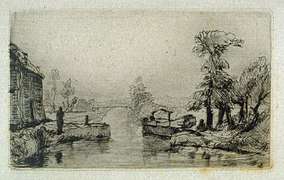 The Duke's Cut near Oxford (1833), Fine Arts Museums of San Francisco
The Duke's Cut near Oxford (1833), Fine Arts Museums of San Francisco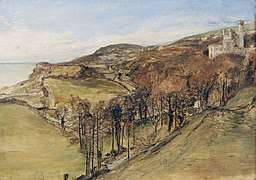 Mount Edgecombe, Devonshire (undated), Norfolk Museums Collections
Mount Edgecombe, Devonshire (undated), Norfolk Museums Collections Anchor Inn or Bridge House, Aylsham (undated), Norfolk Museums Collections
Anchor Inn or Bridge House, Aylsham (undated), Norfolk Museums Collections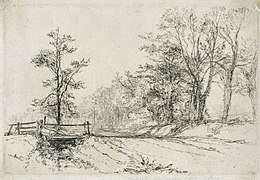 Whitlingham Lane by Trowse (undated), Norfolk Museums Services
Whitlingham Lane by Trowse (undated), Norfolk Museums Services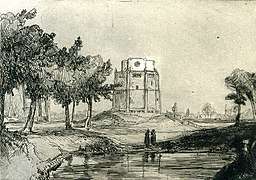 The Red Mount Chapel, King's Lynn (undated), Norfolk Museums Collections
The Red Mount Chapel, King's Lynn (undated), Norfolk Museums Collections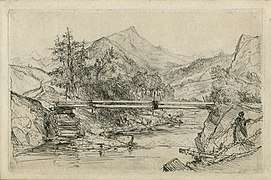 Grindlewald near Interlaken (undated), Norfolk Museums Collections
Grindlewald near Interlaken (undated), Norfolk Museums Collections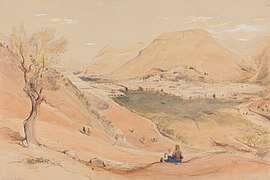 Nablous, Jordan (1841), Yale Center for British Art
Nablous, Jordan (1841), Yale Center for British Art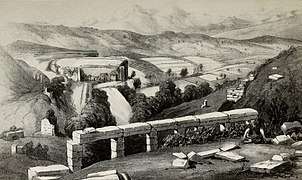 Selge (published in Travels in Lycia, Milyas, and the Cibyrati (1847))
Selge (published in Travels in Lycia, Milyas, and the Cibyrati (1847))
Notes
- A watercolour copy of Linnell's original oil painting of E. T. Daniell remained with Linnell and was in his studio at his death, an indication of the personal attachment that Linnell felt for Daniell.[1][2]
- Anne Daniell's portrait was painted in Norwich by Daniell's friend Linnell a year before her death.[16]
- The family name was at times spelt Daniel.[17]
- Parish records show that Thomas Daniell died at Snettisham Lodge on 17 March 1806,[22] and was buried at Snettisham the following week. The tablet to his memory in Snettisham Church gives his age as 53, but the parish records show he died at 73.[23][24]
- On 8 February 1840, Linnell's diary mentioned: "to Mr. Daniell to see Roberts's drawings of Egypt & Palestine, etc.".[50]
- Spratt's map of Lycia, Milyas and the Cibyratis shows the routes taken by Daniell, Forbes and Spratt through Lycia during March July 1842.[53]
- Edward Daniell's last letter was included in its entirety in chapter IX of Edward Forbes and Thomas Spratt's Travels in Lycia, Milyas, and the Cibyratis, in company with the Late E.T. Daniell (Volume II).[65]
- A letter from Daniell's brother-in-law in The Athenæum in 1842 confirmed the artist's death to the public: "The hopes we expressed last week, that there might be some error in the reported death of the Rev. E.T. Daniell, must, we fear, be abandoned, as the following letter from his brother-in-law appears to be conclusive on the subject: - Fakenham, Norfolk, Nov. 14th, 1842. My attention has been directed to a paragraph in your last number, expressive of surprise at "an announcement in the papers of the death of the Rev. E.T. Daniell." and of "hope that the statement may be an error." I regret to inform you that the announcement is too certainly true; that Mr. Daniell’s friends in England are in possession of a letter from Mr. John Purdie, H.B.M.V.-Consul at Adalia, communicating the mournful intelligence of Mr. Daniell’s death, at that gentleman’s house, on the 24th September last, after a protracted illness of (with intervals of convalescence) more than two months, during which lengthened period of suffering. It is but justice to her majesty’s Vice-Consul to say, that all accounts concur in stating that the deceased received from that gentleman the most remitting kindness and attention. I am, &c. ROBERT CAMPBELL".[67]
- David Wilkie was a British painter who died and was buried at sea, off Gibraltar, returning from his first trip to the Middle East.[68]
- Alfred Story described Linnell's painting Noon as "one of the best works he ever did in the Italian style of which it is a notable example" and "peculiar tor its freshness and purity of colour".[77]
References
- Beecheno 1889, p. 13.
- "Collection online". The British Museum. 2019. Retrieved 4 May 2019.
- Cundall 1920, p. 12.
- Moore 1985, p. 9.
- Cundall 1920, p. 1.
- Day 1968, p. 7.
- Hemingway 1979, pp. 9, 79.
- Walpole 1997, pp. 10–11.
- Searle 2015, p. 70.
- Rajnai & Stevens 1976, p. 13.
- Hemingway 1979, p. 17.
- Rajnai & Stevens 1976, p. 4.
- Clifford 1965, pp. 6–7.
- Clifford 1965, pp. 10–12.
- Moore 1985, p. 12.
- Dickes 1905, p. 546.
- Oliver 1896, p. 385.
- Dickes 1905, p. 543.
- Oliver 1896, pp. 184–186.
- Oliver 1909, p. 177.
- Oliver 1909, p. 225.
- Image 587 in "Baptisms, marriages and burials, 1773-1782", FamilySearch (Image 587). Citing Bishop's transcripts for Yarmouth. (registration required)
- Beecheno 1889, p. 5.
- Mackie 1901, p. 47.
- "Thomas Daniell". Legacies of British Slave-ownership. UCL Department of History. 2019. Retrieved 30 April 2019.
- Beecheno 1889, pp. 5–6.
- Smail 2004.
- Cundall 1920, p. 32.
- Thistlethwaite 1974, p. 1.
- "University and Clerical Intelligence". The Standard. London. 28 November 1828.
- Beecheno 1889, p. 6.
- Searle 2015, p. 65.
- Searle 2015, p. 113.
- Dickes 1905, pp. 543–544.
- Thistlethwaite 1974, p. 2.
- Hamilton 1997, pp. 319–320.
- Thistlethwaite 1974, p. 3.
- Moore 1985, pp. 97–98.
- Searle 2015, p. 64.
- Dickes 1905, p. 544.
- Story 1892, p. 267.
- Dickes 1905, pp. 544–45.
- White 1845, p. 178.
- Beecheno 1889, p. 16.
- "History of Norwich Castle". Norwich Castle Museum & Art Gallery. Norfolk Museums. 2020. Retrieved 6 June 2020.
- Beecheno 1889, p. 9.
- Dickes 1905, p. 545.
- Dickes 1905, p. 560.
- Dickes 1905, p. 548.
- Beecheno 1889, p. 20.
- Thistlethwaite 1974, p. 4.
- Binyon 1899, p. 211.
- Spratt, Thomas. "Map of Lycia, Milyas and the Cibyratis". Gallica. BnF. Retrieved 7 June 2020.
- Beecheno 1889, p. 26.
- Beecheno 1889, p. 22.
- Binyon 1899, p. 212.
- Forbes 1842, pp. 1014–1015.
- Hill 1895, p. 116.
- Beecheno 1889, p. 23.
- Duggan 2019, p. 209.
- Duggan 2019, p. 25.
- Severis 1999, pp. 100–102.
- Dickes 1905, p. 549.
- Binyon 1899, p. 214.
- Forbes, Spratt & Daniell 1847, pp. 1–36.
- "Obituary. The Rev. E.T. Daniell". The Art Journal: 36. 1 February 1843.
- "Our Weekly Gossip". The Athenæum (786): 993. 19 November 1842. Retrieved 1 May 2019.
- Gower 1902.
- "Will of Reverend Edward Thomas Daniell, Clerk of Park Street Grosvenor Square, Middlesex". The National Archives. Retrieved 17 December 2018.
- Dickes 1905, pp. 560–561.
- Sheldon 2009, pp. 617–618.
- Quiller-Couch 1895, pp. 6–7.
- Beecheno 1889, p. 19.
- Story 1892, p. 268.
- Story 1892, pp. 268–269.
- Hamilton 1997, p. 356.
- Story 1892, pp. 269–270.
- Clifford 1965, p. 51.
- Walpole 1997, p. 159.
- Walpole 1997, p. 158.
- Rajnai & Stevens 1976, p. 43.
- Graves 1905, p. 241.
- Graves 1895, p. 71.
- Clifford 1965, p. 71.
- Proceedings of the Geological Society of London, November 1833 to June 1838. II. London: R. & J.E. Taylor. p. 340.
- Thistlethwaite 1974, p. 6.
- Salaman 1914, pp. 33, 180.
- Searle 2015, p. 106.
- Thistlethwaite 1974, pp. 1, 4.
- Thistlethwaite 1974, p. 8.
- Searle 2015, pp. 65–69.
- Searle 2015, p. 68.
- Daniell & Palgrave 1882.
- "Twelve Etchings by the Rev. E. T. Daniell (book)". Norfolk Museums Collections. Retrieved 4 May 2019.
- Searle 2015, p. 69.
- Hardie 1921, p. 15.
- Walpole 1997, p. 1591.
- "Art in Norwich (March to September 2016)". Issuu. 2016. p. 47. Retrieved 18 December 2018.
- "Exhibitions". EAAF. Retrieved 18 June 2020.
- "Lot 653: Rev. Edward Thomas Daniell (1804–1842) Norwich Sch". invaluable. Retrieved 22 April 2019.
- "Lot Description". Keys Auctioneers and Valuers. Retrieved 22 April 2019.
Bibliography
- Beecheno, Frederick R. (1889). E.T. Daniell: a memoir. Privately printed (Limited edition of 50 copies). OCLC 27318993.CS1 maint: ref=harv (link)
- Binyon, Laurence (1899). "Edward Thomas Daniell, Painter and Etcher". The Dome. IV (12). OCLC 665160418.CS1 maint: ref=harv (link)

- Clifford, Derek Plint (1965). Watercolours of the Norwich School. Cory, Adams & Mackay. OCLC 1624701.CS1 maint: ref=harv (link)
- Cundall, Herbert Minton (1920). Holme, Geoffrey (ed.). The Norwich School. London: Geoffrey Holme Ltd. OCLC 651802612.CS1 maint: ref=harv (link)

- Daniell, Edward Thomas; Palgrave, Robert Harry Inglis (1882). Twelve etchings by the Reverend E.T. Daniell with a short notice of his life by R.H. Inglis Palgrave. Great Yarmouth. OCLC 558920940.CS1 maint: ref=harv (link)
- Day, Harold (1968). East Anglian Painters. II. Eastbourne, UK: Eastbourne Fine Art. ISBN 978-0-902010-10-9.CS1 maint: ref=harv (link)
- Dickes, William Frederick (1905). The Norwich school of painting: being a full account of the Norwich exhibitions, the lives of the painters, the lists of their respecitve exhibits and descriptions of the pictures. Norwich: Jarrold & Sons Ltd. OCLC 558218061.CS1 maint: ref=harv (link)

- Duggan, T. M. P. (2019). Antalya: Some Accounts, Notices, References and Reports of the City of Antalya, and its History Published in English during the 19th Century, Together with Some Earlier References to the City, its Name and its History Published in English from the 16th to the 19th c. (PDF) (in English and Turkish). Translated by Bozkurtoğlu Özcan, Ö. Antalya, Turkey: Akedeniz University. ISBN 978-605-4483-51-8.CS1 maint: ref=harv (link)

- Forbes, Edward (26 November 1842). "The Late Rev. E.T. Daniell". The Athenaeum (787): 1014–15. Retrieved 17 December 2018.CS1 maint: ref=harv (link)

- Gower, Ronald Sutherland (1902). Sir David Wilkie. London: G. Bell and Sons.CS1 maint: ref=harv (link)

- Graves, Algernon (1905). The Royal Academy of Arts; a complete dictionary of contributors and their work from its foundation in 1769 to 1904. 2. London: H. Graves.CS1 maint: ref=harv (link)

- Graves, Algernon (1895). A dictionary of artists who have exhibited works in the principal London exhibitions from 1760 to 1893. London: H. Graves. OCLC 758406892.CS1 maint: ref=harv (link)

- Hamilton, James (1997). Turner. London: Hodder & Stoughton. pp. 318–20. ISBN 140006015X.CS1 maint: ref=harv (link) (registration required)
- Hardie, Martin (1921). The British school of etching, being a lecture delivered to the Print Collectors' Club. London: Print Collectors' Club. ISBN 978-1-164-14764-0.CS1 maint: ref=harv (link)

- Hemingway, Andrew (1979). The Norwich School of Painters 1803–1833. Oxford: Phaidon. ISBN 978-0-7148-2001-9.CS1 maint: ref=harv (link)
- Hill, G.F. (1895). "Inscriptions from Lydia and Pisidia copied by Daniell and Fellows". The Journal of Hellenic Studies. 15. Retrieved 17 December 2018.CS1 maint: ref=harv (link)

- Mackie, Charles (1901). Norfolk Annals: A Chronological Record of Remarkable Events in the Nineteenth Century. I (1801-1850). Norwich: Norfolk Chronicle. OCLC 17339408.CS1 maint: ref=harv (link)

- Moore, Andrew W. (1985). The Norwich School of Artists. Norwich: HMSO/Norwich Museums Service. ISBN 978-0-11-701587-6.CS1 maint: ref=harv (link)
- Oliver, Vere Langford (1909). Caribbeana : being miscellaneous papers relating to the history, genealogy, topography, and antiquities of the British West Indies. I. London: Mitchell, Hughes and Clarke. LCCN 09029898.CS1 maint: ref=harv (link)

- Oliver, Vere Langford (1896). The history of the island of Antigua, one of the Leeward Caribbees in the West Indies, from the first settlement in 1635 to the present time. II. London: Mitchell and Hughes. OCLC 908980133.CS1 maint: ref=harv (link)

- Quiller-Couch, Arthur Thomas (1895). Journals and Correspondence of Lady Eastlake. 1. London: John Murray. OCLC 833587661.

- Rajnai, Miklos; Stevens, Mary (1976). The Norwich Society of Artists, 1805–1833: a dictionary of contributors and their work. Norwich: Norfolk Museums Service for the Paul Mellon Centre for Studies in British Art. ISBN 978-0-903101-29-5.CS1 maint: ref=harv (link)
- Salaman, Malcolm C. (1914). Holme, Charles (ed.). The great painter-etchers from Rembrandt to Whistler. London: The Studio Ltd. LCCN 14002883.CS1 maint: ref=harv (link)

- Searle, Geoffrey R. (2015). Etchings of the Norwich School. Norwich: Lasse Press. ISBN 978-0-95687-589-1.CS1 maint: ref=harv (link)
- Severis, Rita C. (March 1999). Although to sight lost, to memory dear: representations of Cyprus by foreign travellers/artists 1700-1955 (Thesis). 1. University of Bristol. OCLC 53550397. Retrieved 23 April 2019.CS1 maint: ref=harv (link)
- Sheldon, Julie (2009). The Letters of Elizabeth Rigby, Lady Eastlake (PDF). Liverpool University Press. ISBN 978-1-84631-194-9.CS1 maint: ref=harv (link)

- Smail, Richard (2004). "Daniell, Edward Thomas". Oxford Dictionary of National Biography. Oxford University Press. Retrieved 17 December 2018.CS1 maint: ref=harv (link)
- Story, Alfred Thomas (1892). "XVII". The Life of John Linnell. 1. Bentley and Son, London. OCLC 833744497.CS1 maint: ref=harv (link)

- Thistlethwaite, Jane (1974). The etchings of E.T. Daniell. Norwich: Norfolk Archaeology, vol.36, pt.1. OCLC 1979600.CS1 maint: ref=harv (link)
- Walpole, Josephine (1997). Art and Artists of the Norwich School. Woodbridge: Antique Collectors' Club. ISBN 978-1-85149-261-9.CS1 maint: ref=harv (link)
- White, Joseph Blanco (1845). The life of Joseph Blanco White. III. London: J. Chapman.CS1 maint: ref=harv (link)

Further reading
- Dobson, David (1987). American vital records from the Gentleman's magazine, 1731–1868. Baltimore: Genealogical Pub. Co. ISBN 978-0-8063-1177-7.
- Forbes, Edward; Spratt, Lieutenant Thomas Abel Brimage; Daniell, Edward Thomas (1847). Travels in Lycia, Milyas, and the Cibyratis, in company with the Late E.T. Daniell. London: John van Voorst. LCCN 05010095.CS1 maint: ref=harv (link) Volumes 1 and 2

External links
| Wikimedia Commons has media related to Edward Thomas Daniell. |
- 346 works (including 158 works with an image) relating to Edward Thomas Daniell in the Norfolk Museums Collections
- 141 works by Edward Thomas Daniell in the British Museum.
- 17 works by Edward Thomas Daniell in the Yale Center for British Art
- Parish records for Banham, Norfolk, from 19 October 1832 – 23 March 1834, written by Edward Thomas Daniell: 1832(image 64 onwards), 1833(image 60 onwards) and 1834(image 56 onwards). FamilySearch (registration required)
- Extract of a letter from Edward Daniell to The Athenaeum, describing some of the events of the expedition in Lycia
